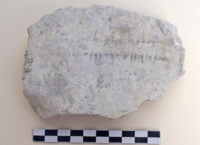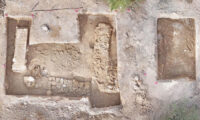 Excavations of the ancient port city of Kition (modern-day Larnaca) in Cyprus have unearthed a pit full of ostraca (potsherds, slabs, stones) inscribed in Phoenician that document the business transacted at the bustling harbor town in the 1st millennium B.C.
Excavations of the ancient port city of Kition (modern-day Larnaca) in Cyprus have unearthed a pit full of ostraca (potsherds, slabs, stones) inscribed in Phoenician that document the business transacted at the bustling harbor town in the 1st millennium B.C.
Kition was a harbor town long before it was Kition. There is evidence of occupation dating to the Neolithic era, and the Bronze Age settlement used what is now one of four salt lakes in Larnaca as a port since at that time it had access to the sea. When that access point silted up in the 13th century B.C., the settlement moved a little north to make use the natural bay there and grew into the Mycenaean city of Kition.
Phoenicians settlers took over in the 9th century B.C., the first known Phoenician colony. They retained control of Kition until Cyprus was conquered by Alexander the Great in 333 B.C. The Phoenicians made effective use of Kition’s fine port and natural resources. They exported oil, timber and salt harvested from the salt lakes and imported goods from all over the Mediterranean.
 Last October’s dig explored the ancient neoria (dockyard) area which had long been obstructed by tennis courts, now removed. Exploratory trenches north and east of the tennis courts revealed evidence that the ancient port covered the entire site. It was a “closed port,” as Strabo called it, meaning it was only accessible from the north, and was constructed to berth large triremes. Coming into Kition bay from the north, the triremes could slip right in, stern first, to the covered ship sheds. The remains of those sheds, massive blocks of limestone, were unearthed in the excavation.
Last October’s dig explored the ancient neoria (dockyard) area which had long been obstructed by tennis courts, now removed. Exploratory trenches north and east of the tennis courts revealed evidence that the ancient port covered the entire site. It was a “closed port,” as Strabo called it, meaning it was only accessible from the north, and was constructed to berth large triremes. Coming into Kition bay from the north, the triremes could slip right in, stern first, to the covered ship sheds. The remains of those sheds, massive blocks of limestone, were unearthed in the excavation.
Εxcavation to the East of the boatsheds revealed at least one additional ramp, evidenced by a pillar base. This base is constructed of a huge limestone block resting on a strong massif of blocks. To the East extends a sandstone wall, which connects with another base-like structure, probably functioning as part of a closing wall of the building, the archaeologists say.
As a result of excavations at the site, the researchers believe that a building may be reconstructed comprised of seven parallel rows of ramps, open to the harbor to the north, delimited by terracing walls on its western and southern sides and by a wall made of a succession of bases and supporting pillars on its eastern side.
Exploration of the Iron Age stratigraphy in this trench reached Classical levels that represent the years 510 – 323 BC.
Architectural features from that era are poorly preserved, the report states, but a pit was excavated which the archaeologists found filled with Phoenician ostraca, or inscribed materials. This concentration of administrative documents proves the existence in the vicinity of a scribal office, linked to the royal administration.
The variety of inscribed materials is striking, including pottery sherds, limestone and gypsum plaques — and even pebbles, the archaeologists say.
Here is an amazing digital reconstruction of the trireme sheds and the port of Kition.
Kition was just one of the ancient cypriot city-kingdoms.
The folks, who in the 14th century BC went down near Cyprus with the “Uluburun ship”, i.e. incl. all their trade goods, however, might already have come from Kition:
en.wikipedia.org/wiki/Uluburun_shipwreck#Cargo
:hattip:
————-
“it can be assumed that the ship set sail from either a Cypriot or Syro-Palestinian port. The Uluburun ship was undoubtedly sailing to the region west of Cyprus, but her ultimate destination can be concluded only from the distribution of objects matching the types carried on board. It has been proposed that ship’s destination was a port somewhere in the Aegean Sea. Rhodes, at the time an important redistribution centre for the Aegean, has been suggested as a possible destination. According to the excavators of the shipwreck, the probable final destination of the ship was one of the Mycenaean palaces, in mainland Greece.”
————-
😮 This is –not at all– about the RAVEN and Poe, as it was announced. Nonetheless, I feel one of these POE–ms coming on :boogie:
————-
This thrilled me—filled me with drastic terrors never felt before; For we cannot help administer a wrongly posted Raven evermore. Dark and sinister, that birdie swallowed ‘Lophophora’, alas Peyote, but also two posts on the Cyprus shipyard and a Mexican coyote.
————-
🙁